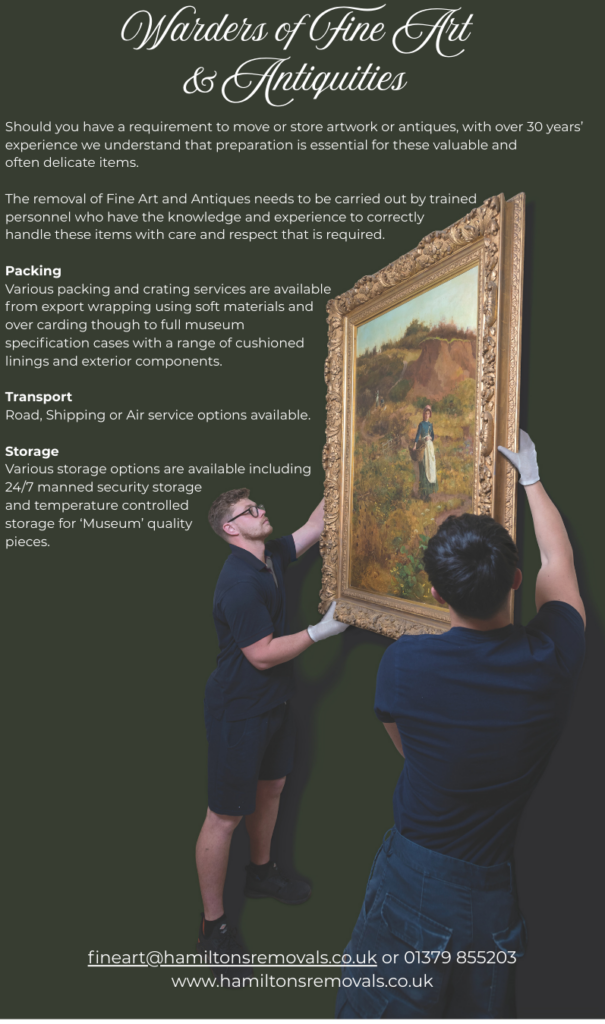Blog
Why do Valuable Artworks and Antiques Need to be Moved?

This article looks at the reasons why artworks are moved so often. Any move requires careful planning and handling, particularly if the pieces are valuable or large.
Hamiltons Removals can help you move your artwork, wherever it needs to go within the UK; we also offer fine art storage services as well.
This article is a three- to four-minute read.
The UK is one of the biggest art markets in the world, accounting for almost a fifth of the global art trade. This means many valuable pieces will be either heading out of, or into, the country, for a variety of reasons. Here, Hamiltons Removals look at some of the more specific reasons for moving artworks – and how we can help.
Antiques Transportation in the UK from Hamiltons Removals
We have more than three decades of experience in moving artwork as well as people. We understand the need to handle all items with care and respect. For more details about our antiques transportation services – which can include shipping and storage – follow this link.
The Global Art Market
The global art market last year was worth around £44 billion. The figure takes into account commission and transportation costs, meaning there is a lot of art and antiques being moved between auction houses, dealers and buyers.
House Moves
Private collectors and households with artworks move house, just like anyone else. Some of the pieces may not have much monetary value, but it is still highly prized by the owners.
This is particularly true if the pieces are part of an inheritance. Antiques and other heirlooms can be passed down through generations of the same family, often as the result of a special bequest. Whatever the reason, it still usually means moving the artwork from one place to another.
Exhibitions and Loans
Many museums and galleries have pieces which are on loan from other institutions. For instance, the National Gallery in London has loaned out works by Constable, Turner, Monet, Vermeer and many other artists within the last 18 months. These have been exhibited in Cambridge, Bristol, Edinburgh, York and many other locations in the UK and overseas.
These loans may be to ensure the pieces reach a wider audience, or to commemorate a particular anniversary, or to help with academic research. Not only do the pieces have to be transported when loaned out, they also need to be transported back to their original destination once the loan period is over.
Conservation Work
Artwork, and particularly paintings, often need to be restored to guard against ageing, dirt, and environmental pollutants. Specialists repair tears, cracks and discolouring to return the piece closer to its original appearance.
While many of the larger museums and galleries have their own conservation studios on site, many smaller institutions don’t. If they want a piece restored, they have the choice of sending it to one of their bigger neighbours, or to one of the independent, privately-owned studios which operate across the UK. These offer specialised services to private collectors, art dealers and auction houses as well.
Storage
Sometimes pieces need to be put into storage, not because they need to be restored, but because their original home is undergoing refurbishment works. In cases like these, the works need to be stored in strictly controlled environments (relating mainly to the temperature and humidity) to ensure it isn’t damaged.
Antiques Transportation and Fine Art Storage from Norfolk-based Hamiltons Removals
At Hamiltons Removals, we can transport your artwork anywhere in the UK by land, sea or air. When it comes to storage, we can offer you several options, including 24/7 manned security storage and temperature-controlled environments for ‘Museum’ quality pieces.
And when it comes to packing materials, we stock soft wrapping materials and full museum specification cases.
So whether you are an auction house, a collector, a museum curator – or maybe you just have some artwork or antiques and are moving house – we can help.
For more details, you can email fineart@hamiltonsremovals.co.uk or call us on 01379 855203.
FAQS:
What are the biggest challenges when moving artwork?
The biggest challenges are environmental factors like temperature and humidity, physical damage from improper packing and handling, and the unique requirements for different types of artwork, like sculptures or large paintings. Sculptures in particular can be large and irregularly shaped. Custom-built storage solutions may be necessary.
Does Hamiltons Removals sell its own packaging materials?
Yes, we stock a range of high-quality packaging materials in our online shop. These include double-walled cartons, bubblewrap and packing paper, and bespoke products such as cartons for bikes, golf clubs, TVs, DVDs, and glassware.
However, if you have anything which is particularly valuable – including artwork and antiques – then we would recommend having it packed (and unpacked) by our team of trained professionals.
Can Hamiltons store items other than artworks?
Yes, we have two Safe’N’Stored sites, at Harleston and Aldeby. The former has a number of self-storage rooms which can be rented for as little as £65 a month, while the latter has self-storage containers which are ideal for larger items such as vehicles and caravans. (Prices for these units start at £52 a month plus VAT).
The Biggest Classic Car Rallies in the UK
A classic car rally is a frequent sight across the UK and overseas, with motoring enthusiasts taking the chance to meet up with like-minded ‘petrolheads’ and share their common interests.
This article looks at the biggest rallies in the UK, when they are held, and which types of vehicles they usually attract.
And if you are planning to attend any of the events, but you would prefer to have someone else take care of the transportation of your prized possession, then Hamiltons Removals can ensure it arrives there safely.
This article is a four-minute read.

The historic vehicle industry is a big contributor to the UK’s economy, with a 2020 report putting the value at £18.3 billion. This figure includes racing events, owner clubs, museums, specialist magazines – and rallies, where thousands of like-minded enthusiasts can meet up and share their passion for classic cars.
Here, Hamiltons Removals, who offer classic car transportation across the UK, look at some of the biggest events held in this country.
Vintage Car Transportation from Hamiltons Removals
At Hamiltons Removals, we can help if you want to move your prized vehicle within the UK, Europe, or further afield. While many enthusiasts like to drive their own car to rallies, we appreciate that it’s not always that simple – and we can take a lot of the stress out of the whole process by ensuring it gets there safe and sound.
The NEC Classic Motor Show
Its official title in 2025 will be the Lancaster Insurance Classic Car Show. This is the UK’s largest indoor classic car show and is usually held at the NEC in Birmingham every November. It features more than 2,500 vehicles from motoring clubs, a vast trade area, and interactive exhibits (including where children get the chance to drive small vehicles). There’s also a restoration workshop if you need any tips on maintaining your own vehicle. And it’s not just for UK cars – there’s a dedicated section for motorbikes, as well as plenty of American muscle cars.
The Silverstone Classic
Also known as the Silverstone Festival, the Classic is held at the F1 track in Northamptonshire every August. Like the NEC Classic, there’s a mixture of trade stands and exhibits, as well as some live music. However, the focus is on racing – F1 (often including some famous names from the past), GT, Sports and Touring Car events were all on the calendar in 2025. Many enthusiasts camp out at the track for the whole weekend.
Next year (2026), the format is due to change slightly when the event will be run alongside CarFest, which has many of the same elements, but the focus will be on charity fundraising.
The Goodwood Festival of Speed and Revival Meeting
The Festival of Speed is a comparatively new entry onto the motorsport calendar. It started in 1993 and takes place at Goodwood House in West Sussex (where there was a racing circuit from the 1940s-60s that was restored and improved in the 1990s).
There are plenty of different races – a hillclimb, a soapbox challenge and a rally stage – all held within the grounds but using different circuits. The Festival of Speed is usually held in July, and Goodwood also hosts a Revival meeting later in the year. Vehicles here usually date from the original track’s heyday. In both cases, there are dedicated parking areas for classic cars (even if they aren’t taking part in any races) so enthusiasts can come and ‘browse’.
The Donington Historic Festival
This festival is held at the Derbyshire racing circuit in May. Again, it’s a significant event for historic racing, attracting hundreds of world-class racing cars. However, there are plenty of opportunities for owners to attend (with their cars) if they are registered with the appropriate owner’s club. Last year, the following clubs attended – Alfa Romeo, Aston Martin, Jaguar, Ferrari, Lotus, MG and Porsche – and that’s by no means a full list.
Classic Car Transportation across the UK from Hamiltons Removals
Of course, there are plenty of other smaller rallies held across the country, many of them for specific clubs or owners. Many people like to drive their own classic cars to these events – but if you have more than one, you prefer to ensure your vehicle looks in pristine condition, or you aren’t sure you are allowed to drive it on public roads, then you can entrust it to Hamiltons Removals.
We offer covered car and single car transportation from our base close to the Norfolk/Suffolk border and have a number of purpose-built transporters which we use to ensure your vehicle arrives safely at its destination, whether that’s in the UK or overseas.
For more information on our specialist vehicle services, follow this link, email us at vehicles@hamiltonsremovals.co.uk or call us on 01379 855203.
FAQS:
What sort of vehicles can Hamiltons Removals transport?
Whatever age or type of vehicle you have – classic, antique, or vintage – we can transport it safely to its destination. And we don’t just move historic vehicles; we can help with other types of vehicles (such as tractors) as well. For more information, follow this link.
What is the legal position about driving vintage vehicles on UK roads?
You are allowed to drive a classic car on UK roads, but you must ensure it’s registered with the DVLA and maintained well enough to be roadworthy. While vehicles over 40 years old are generally exempt from annual MOT tests and car tax, you must maintain them in good condition, which may involve a voluntary MOT for peace of mind and safety.
If there have been any substantial changes made to the vehicle in the last 30 years, it may be necessary to have an MOT, even if it is over 40 years old.
If you are in any doubt about its legality or its roadworthiness, you may be better off having it transported by a specialist vehicle transporter such as Hamiltons Removals.











